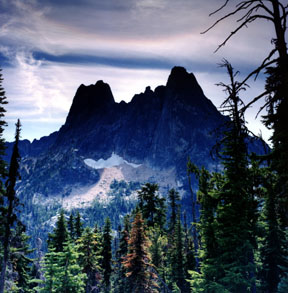Forest Corona
This cousin to the halo formed as the Sun (hidden behind a redwood tree) shone through a misty ground fog. With the Sun blocked out, the corona can be seen where the sun rays penetrate the canopy. At least two concentric bands of alternating red and blue, and possibly a third, can be seen radiating away from the Sun. Coronas are caused by refractions in tiny water droplets. Here is a close-up of the corona. This image was taken from the Damnation Creek Trail in the Del Norte Coast Redwoods State Park.
Print No. A02-13-8
Here are more images from Redwood National and State Parks and the North Coast of California
Oak Crowned by Rare Double Solar Halo
Taken from Mount Diablo State Park, California, this view to the west reveals a rare double halo. Haloes are formed by the reflections and refraction of sunlight in ice crystals within cirrus clouds in the stratosphere. The outer halo seen here is a common halo formed around the Sun at a radius of 22o. To the right and left of the Sun (blocked out behind the oak) you can see arcs of a rare halo at a radius of about 18o. The bright spots in each halo, seen here to the right and left of the Sun (especially the left side of the outer halo), are called sun dogs, mock suns, or in technical lingo, parhelia.
Print No. A99-19-8
Brocken Specter Plane
A Brocken specter (also known as specter, or spectre, of the Brocken) is a well-defined shadow cast by the Sun into the clouds. It is sometimes seen by mountain climbers, on peaks above the clouds, as their own shadow opposite to the Sun's position. This phenomenon is often accompanied by colorful circular bands, which center on the point opposite to the Sun from the observer (anti-solar point). These rainbow-like rings are called a glory and are reflections off of water droplets, much like a rainbow. In this photo, taken from a 737 jet as it was descending into Boise, Idaho, the shadow of the jet is clearly seen and the glory shows that I was sitting near the front of the plane.
This image was awarded Honorable Mention in the Weatherwise Magazine 2001 Weather Photo Contest.
Print No. C00-2-6
Spasm Geyser, Clepsydra Geyser, and Brocken Specter
The steam produced in the Lower Geyser Basin of Yellowstone National Park, Wyoming, reflects the early morning Sun, resulting in another Brocken specter, this time centered around the shadow of the camera (positioned in front of my head).
Print No. A01NW-37-1
More images of Yellowstone Geysers.
The Early Winters Spires are jagged peaks of granite in the North Cascades National Park of Washington. Above these peaks is the lower arc of a 22o halo around the Sun.
Print No. A01NW-19-8
More images from North Cascades National Park
Mount Diablo Hailstorm
Taken from Acalanes Ridge to the west, this springtime storm dumped hail over the western slopes of the mountain. With the thunderhead looming over the peak, the sheets of hail, the bright vertical shafts at the base of the clouds, are visible in this view.
Print No. A98-21-1
More images of Mount Diablo State Park, California
Forest Hailstorm and Ground Fog
The high plateau of the Dixie National Forest is prone to frequent summer thunderstorms. Combined with the high elevation, hailstorms are common. In this case, up to 6 inches (15 cm) of marble-size hail covered portions of the forest. This photo was taken between Cedar Breaks and Navajo Lake at least 2 hours after the storm. As the sun broke through the clouds, the slushy ground developed an eerie ground fog.
Print No. A97SW-39-3
More images from the Dixie National Forest, Utah







